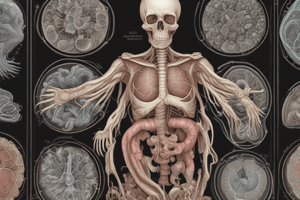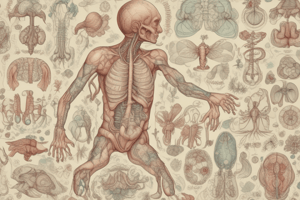Podcast
Questions and Answers
What is the primary site of gas exchange in the respiratory system?
What is the primary site of gas exchange in the respiratory system?
- Trachea
- Bronchi
- Alveoli (correct)
- Diaphragm
What is the effect of pCO2 on oxygen transport?
What is the effect of pCO2 on oxygen transport?
- It decreases oxygen binding to hemoglobin (correct)
- It increases oxygen binding to hemoglobin
- It has no effect on oxygen transport
- It increases the rate of breathing
What is the significance of vital capacity?
What is the significance of vital capacity?
- It determines the rate of breathing
- It measures the oxygen carrying capacity of blood
- It indicates the maximum amount of air that can be breathed out after a maximum inspiration (correct)
- It regulates the transport of CO2 in the blood
Why does diffusion of gases occur in the alveolar region only?
Why does diffusion of gases occur in the alveolar region only?
What happens to the respiratory process in a man going up a hill?
What happens to the respiratory process in a man going up a hill?
What is the site of gaseous exchange in an insect?
What is the site of gaseous exchange in an insect?
What is the significance of the oxygen dissociation curve?
What is the significance of the oxygen dissociation curve?
What is the difference between IRV and ERV?
What is the difference between IRV and ERV?
What is the tidal volume for a healthy human in an hour?
What is the tidal volume for a healthy human in an hour?
What is the comparison of pO2 and pCO2 in the atmospheric air versus the alveolar air?
What is the comparison of pO2 and pCO2 in the atmospheric air versus the alveolar air?
Flashcards are hidden until you start studying
Study Notes
Breathing and Exchange of Gases
- Gills are used by most aquatic arthropods and molluscs for gas exchange, while vascularised bags called lungs are used by terrestrial forms.
- Among vertebrates, fishes use gills, while reptiles, birds, and mammals respire through lungs. Amphibians like frogs can respire through their moist skin.
Human Respiratory System
- The human respiratory system consists of a pair of external nostrils, nasal passage, nasal chamber, pharynx, larynx, trachea, bronchi, bronchioles, and alveoli.
- The larynx is a cartilaginous box that helps in sound production and is called the sound box.
- The trachea is a straight tube that divides into a right and left primary bronchi, which undergo repeated divisions to form secondary and tertiary bronchi and bronchioles.
- Each terminal bronchiole gives rise to a number of thin, irregular-walled, and vascularised bag-like structures called alveoli.
Lungs
- We have two lungs, which are covered by a double-layered pleura with pleural fluid in between, reducing friction on the lung surface.
- The branching network of bronchi, bronchioles, and alveoli comprise the lungs.
Gas Exchange
- The diffusion membrane is made up of three major layers: the thin squamous epithelium of alveoli, the endothelium of alveolar capillaries, and the basement substance in between.
- The solubility of CO2 is 20-25 times higher than that of O2, making it easier for CO2 to diffuse through the membrane.
- Factors in the body are favourable for diffusion of O2 from alveoli to tissues and CO2 from tissues to alveoli.
Transport of Gases
- Blood is the medium of transport for O2 and CO2.
- About 97% of O2 is transported by RBCs, while 3% is carried in a dissolved state through plasma.
- Nearly 20-25% of CO2 is transported by RBCs, 70% is carried as bicarbonate, and 7% is carried in a dissolved state through plasma.
Transport of Oxygen
- Haemoglobin is a red-coloured iron-containing pigment present in RBCs that can bind with O2 in a reversible manner to form oxyhaemoglobin.
- Each haemoglobin molecule can carry a maximum of four molecules of O2.
- Binding of oxygen with haemoglobin is primarily related to partial pressure of O2, and can be affected by partial pressure of CO2, hydrogen ion concentration, and temperature.
Respiratory Mechanism
- Inspiration and expiration are carried out by creating pressure gradients between the atmosphere and alveoli with the help of specialised muscles – intercostals and diaphragm.
- Respiratory rhythm is maintained by the respiratory centre in the medulla region of the brain.
- A pneumotaxic centre in the pons region of the brain and a chemosensitive area in the medulla can alter respiratory mechanism.
Studying That Suits You
Use AI to generate personalized quizzes and flashcards to suit your learning preferences.




